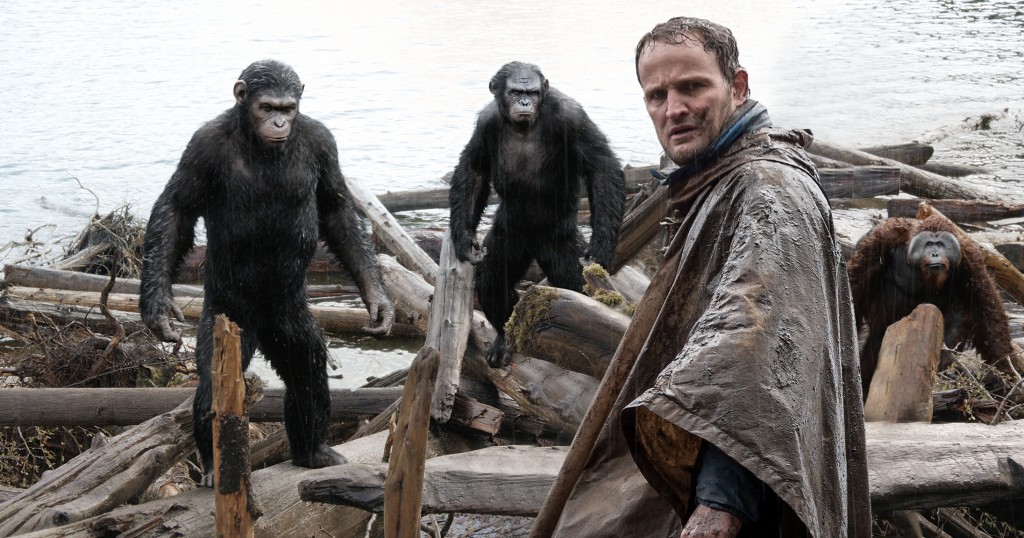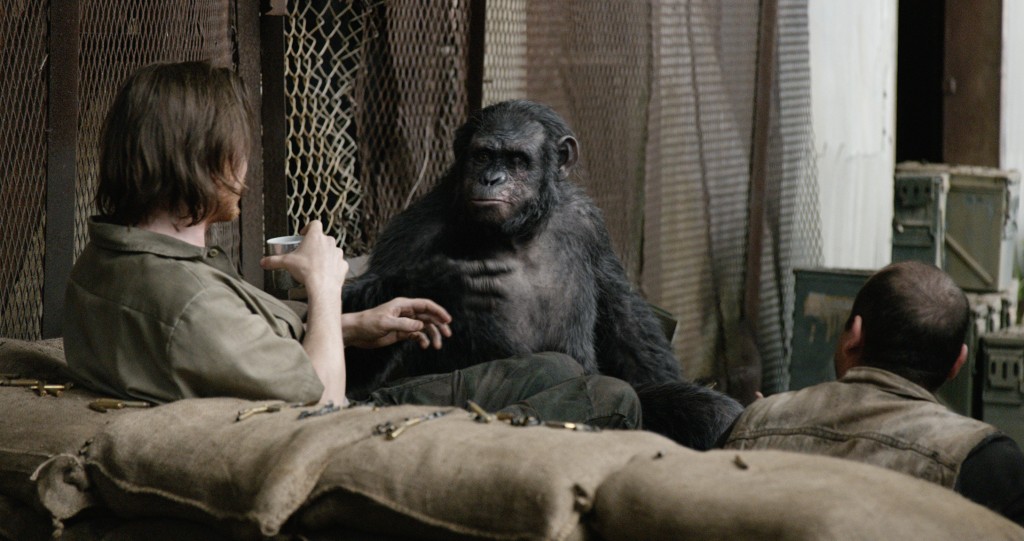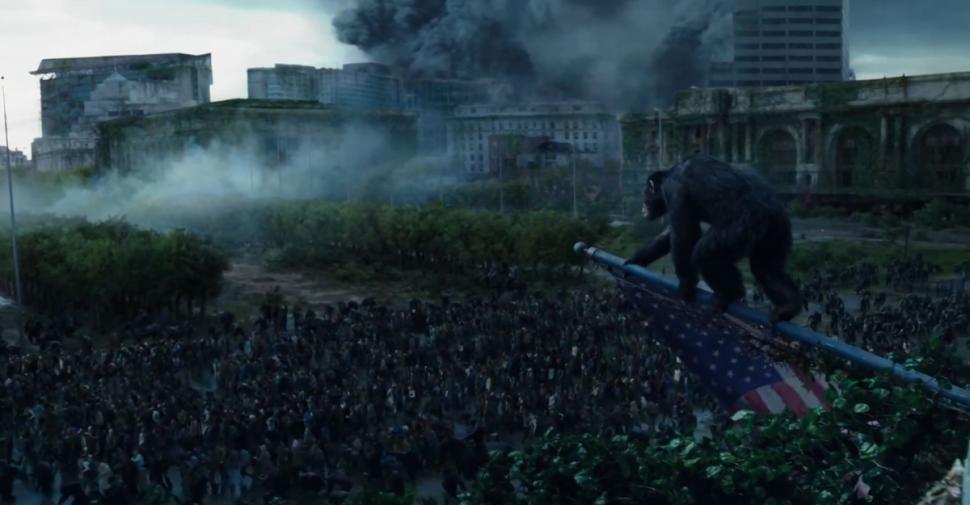The original Planet of the Apes franchise is never truly given its due as a crucial evolutionary link in the history of the blockbuster. In many ways, Apes was the first true science fiction film franchise dynasty. The original 1968 film spawned four sequels and two television series years before George Lucas’ Star Wars would hit screens and forever change the game. Between 1970 and 1975, there was a new Planet of the Apes movie or TV show every year, a level of multimedia expansion all but unheard of even today.
The root of the public’s fascination with Planet of the Apes shares a great deal in common with the other huge sci-fi property of the late 60’s/early 70’s, Star Trek. The Planet of the Apes films presented audiences with a quasi-philosophical meditation on humanity, religion, government oppression, and cold war doomsday fears (with diminishing returns). But, just as Star Trek delivered scenes of Captain Kirk judo chopping giant lizardmen, the Apes films offered the visceral, spectacle thrill of actors in ape makeup riding horses or firing rifles. The moment the first gorilla soldier appears in the original Planet of the Apes is shocking no matter how many times you’ve seen it. It’s like our brains are hardwired to accept what we are seeing as wrong. The original film presents a dystopia that’s horrifying for a simple reason: it’s a future where not only is our world in ruins, but mankind isn’t even in charge of the rubble.
2011’s Rise of the Planet of the Apes was the second (far more successful) attempt to revive the Apes franchise for a contemporary audience and, while it leaves something to be desired in many of its human performances, the film triumphs when it comes to the motion-captured, mostly non-verbal CGI ape performances. Rise has all of the ingredients of the ideal reboot; it’s a movie that does its own thing rather than attempt to halfheartedly copy what’s come before, while touching on many of the same themes and visuals that made the original film so popular. There’s a brief moment in the film where a television screen mentions the launch of the Icarus space ship, which diehard fans will recognize from Planet of the Apes. But it’s a quiet sidenote, a gentle reminder of things to come while the movie gets to the business of depicting hyper-intelligent chimp Caesar’s rebellion against his human oppressors and the initial spread of a contagion that will decimate mankind.
This brings us to Dawn of the Planet of the Apes, the latest and hands down greatest of these films. In Dawn, director Matt Reeves has crafted a sophisticated, stunning piece of science fiction that, like its ape heroes and villains, articulates much by saying very little.
(Spoilers below)
Set ten years after the events of Rise, Dawn wastes no time explaining the new status quo to the audience. A relatively small segment of plague-immune humans in San Francisco faces the total collapse of the fragile society they’ve built if they can’t access and fix a hydroelectric power plant deep in Muir Woods. This brings them into contact (and conflict) with Caesar’s blossoming society of apes who, over the last decade, have developed the ability to talk and read.
It’s fitting that Dawn opens and ends on a closeup of Caesar’s intense gaze. While Rise saw a young Caesar as the unsure leader of a revolution, Dawn presents us with a weary king and struggling husband/father of two. Andy Serkis’ performance as Caesar, a monarch facing hard choices in the midst of an open rebellion against him on the eve of interspecies war, is handily the best, most subdued work of his career. The years have made Caesar harder, but his new friendship with human survivor leader and fellow father Malcolm (Jason Clarke) makes him question himself and his preconceptions about mankind. Clarke’s performance here, while admirable, takes a backseat to the spectacular ape performances of the film but his parallel relationship with Caesar is what grounds the film. Malcolm and Caesar are inherently good people (beings?) trying to do the best they can for their respective families.
Dawn’s other major parallel relationship comes in the form of its choice of villains, Gary Oldman’s struggling human leader Dreyfuss and Caesar’s bloodthirsty bonobo second in command, Koba (Toby Kebbell). Dreyfuss, as the official figurehead of the human survivors, has lost everything but the citizens who have placed their faith in him. As the settlement celebrates the return of electricity to the camp, Dreyfuss can only weep over photos of his dead family on a cracked iPad screen. When Dreyfuss suicidally presses the detonator on a series of explosions that kill many of the apes in the construction site above him, destroying once and for all the fragile hope of peace between man and ape, he tells Malcolm with total conviction that he is “saving humanity.”
Koba, one of a handful of apes who were first introduced in Rise of the Planet of the Apes, is the best, most fully realized bad guy of any movie this year. While Caesar hopes to broker a peace with humanity, or at least be left alone, former lab ape Koba carries many kinds of scars from the hands of humans. When Caesar tells him to “let them carry out their human work” in restoring the powerplant, Koba can only point to his own ravaged body. “Human work? Human WORK? HUMAN WORK?” he growls incredulously. As the film progresses, we watch as Koba’s offenses grow in seriousness, from open defiance of his king to cold blooded murder of humans guarding a weapons stockpile to the attempted murder of Caesar himself in a bid for leadership of the tribe. Having deposed Caesar and drunk on his own power, Koba proves himself a terrifying fascist, forcing humans into cages and murdering his own subjects on a whim. During the film’s thrilling final confrontation between Koba and Caesar atop an uncompleted skyscraper, he removes a girder crushing an injured ape just long enough to take his rifle before leaving him to die. Koba and Dreyfuss are driven to evil acts because they’re too broken to fully function in San Francisco’s new world order, villains whose old emotional wounds have festered.
Although Matt Reeves is best known as the director of Cloverfield and the American remake of Let The Right One In, he distinguishes himself here as a confident and impressive filmmaker. From the film’s opening, a sequence where Caesar and his apes semi-successfully hunt a herd of elk before running into a grizzly bear, we find ourselves with a director who understands the exact formula of action and genuine character focus that a film like this needs. During Koba’s bullet-drenched assault on the human camp, you feel helpless when the camera movement crescendos into a super closeup of him standing on top of an armored humvee as it eerily glides into a metal wall. Dawn’s emotional catharsis, where our band of heroic humans and apes stand and excitedly listen to a song (The Band’s “The Weight”) off a ruined gas station’s newly working CD player is funny, sad and triumphant all at once. Reeves understands that there need to be moments of levity and quiet amidst the apocalyptic carnage and horror, where characters can just breathe and smile for a moment.
Michael Giacchino, no stranger to big budget sci-fi soundtracks with career highlights that include both Abrams’ Star Treks, Brad Bird’s The Incredibles, and a criminally underrated John Carter score, pairs Dawn with a soundtrack that is appropriately alien and somber. With notes of the original Planet of the Apes’ inhuman piano key as well as shades of his own earlier work on Lost, Giacchino’s score evokes the feel of old school Hollywood epics while still sounding like a fully realized, original work. The centerpiece of this, “The Great Ape Processional” captures the film’s grandeur and doom in one really excellent 4:35 piece of music.
The surest marker that Dawn of the Planet of the Apes is an important, vital piece of filmmaking is that it presents us with a premise like talking, horseback riding apes and successfully sells it to us as a compelling, weighty drama. In interviews, Reeves described the film as his take on a The Godfather-esque epic tragedy. While the original Planet of the Apes left audiences with a distraught Charlton Heston pounding futilely before a fallen Statue of Liberty to signal that mankind’s downfall is certain, Dawn reaches the same conclusion in a manner that is perhaps just as heartbreaking: Caesar’s green-speckled eyes stare out into the sunrise, his now exhausted expression resigned this time to a war with humanity that is now inevitable.
Dawn of the Planet of the Apes is in theaters now.






